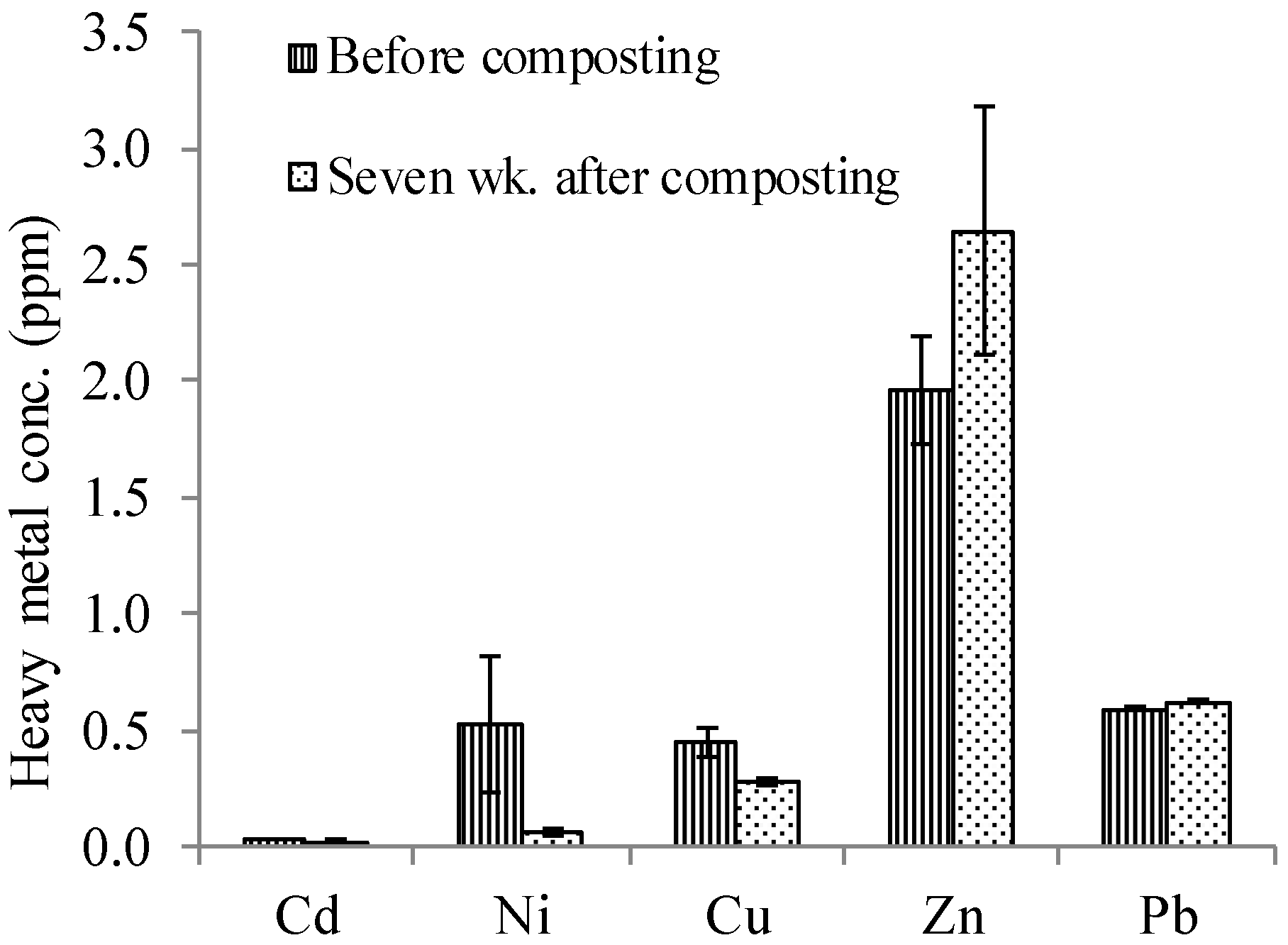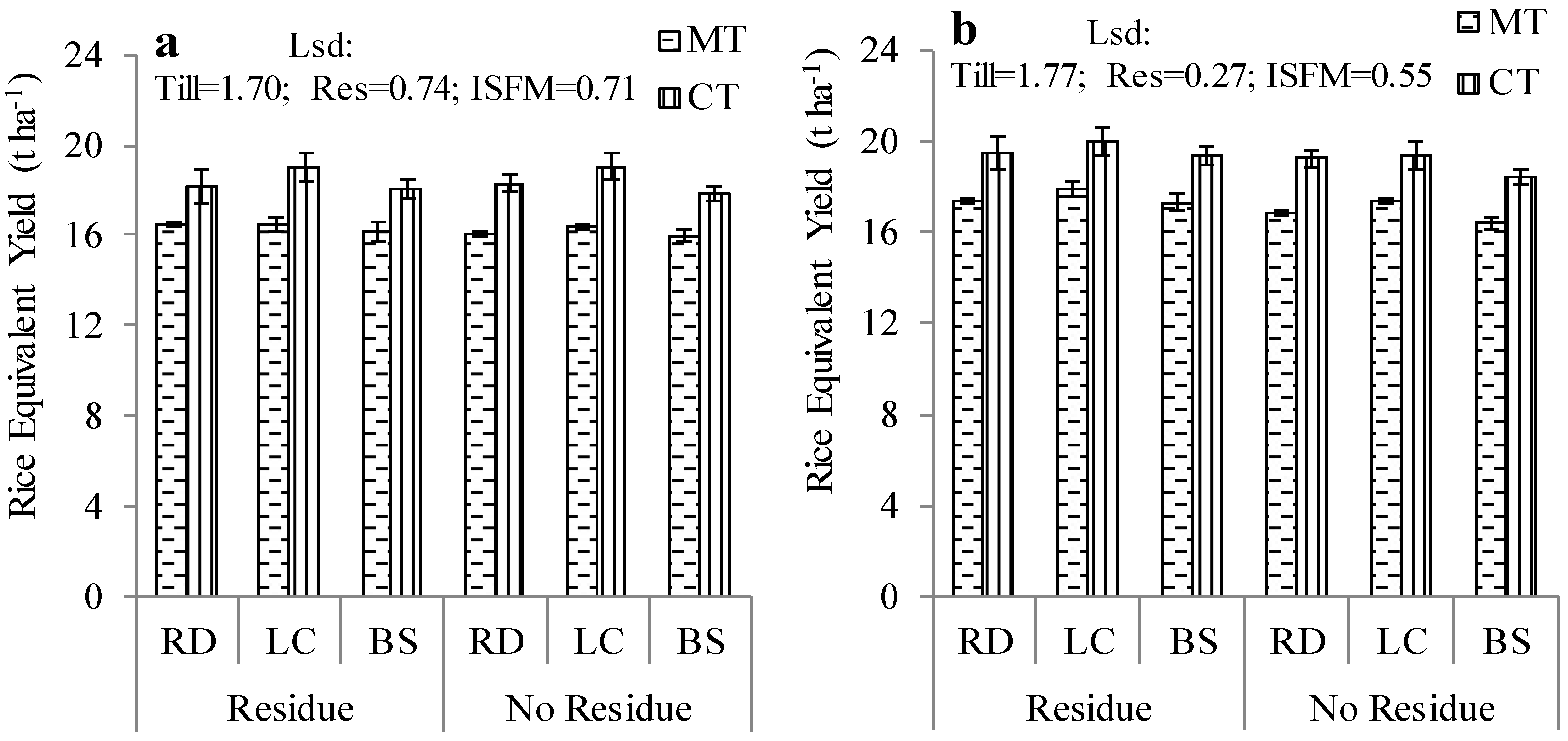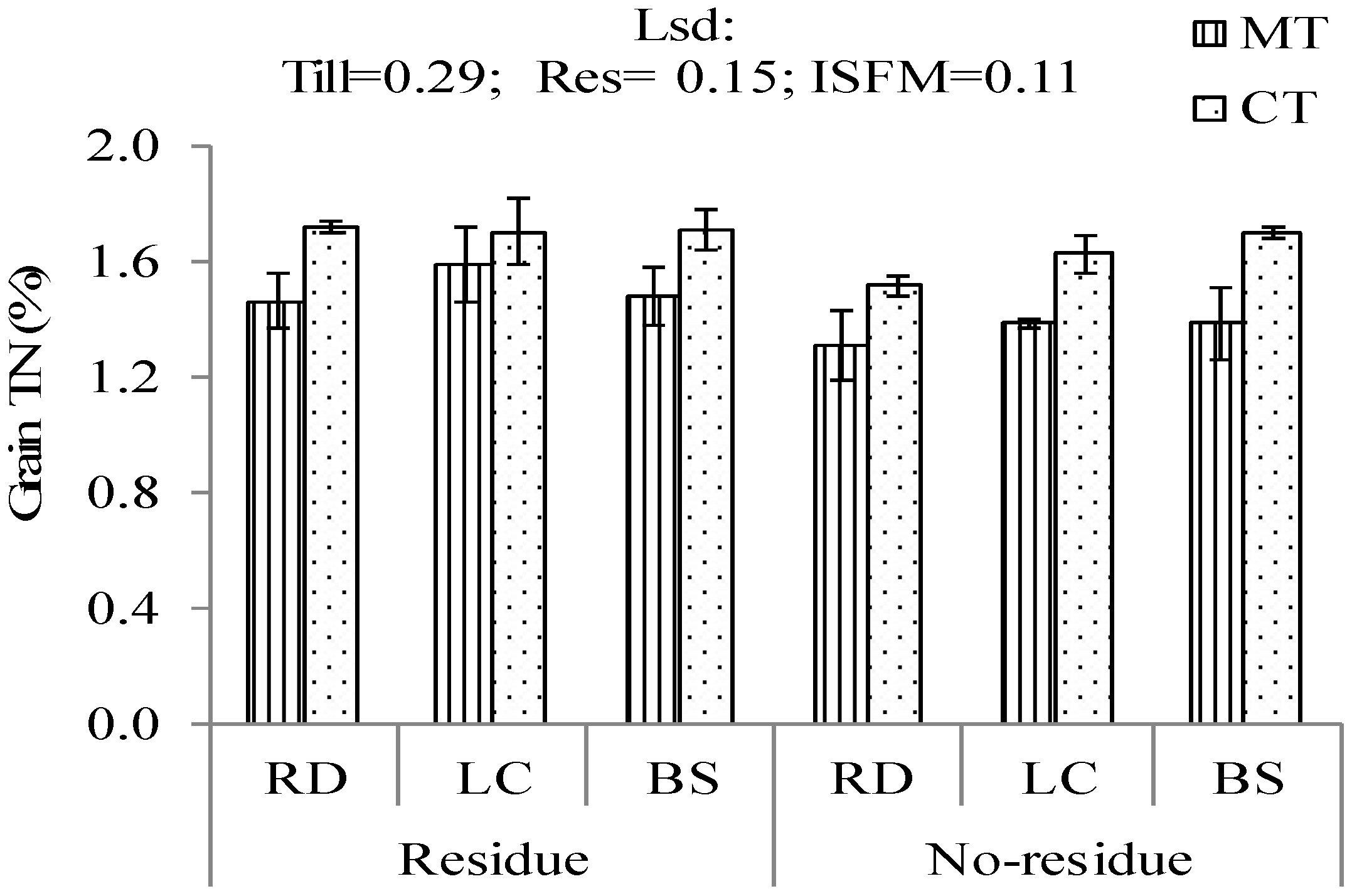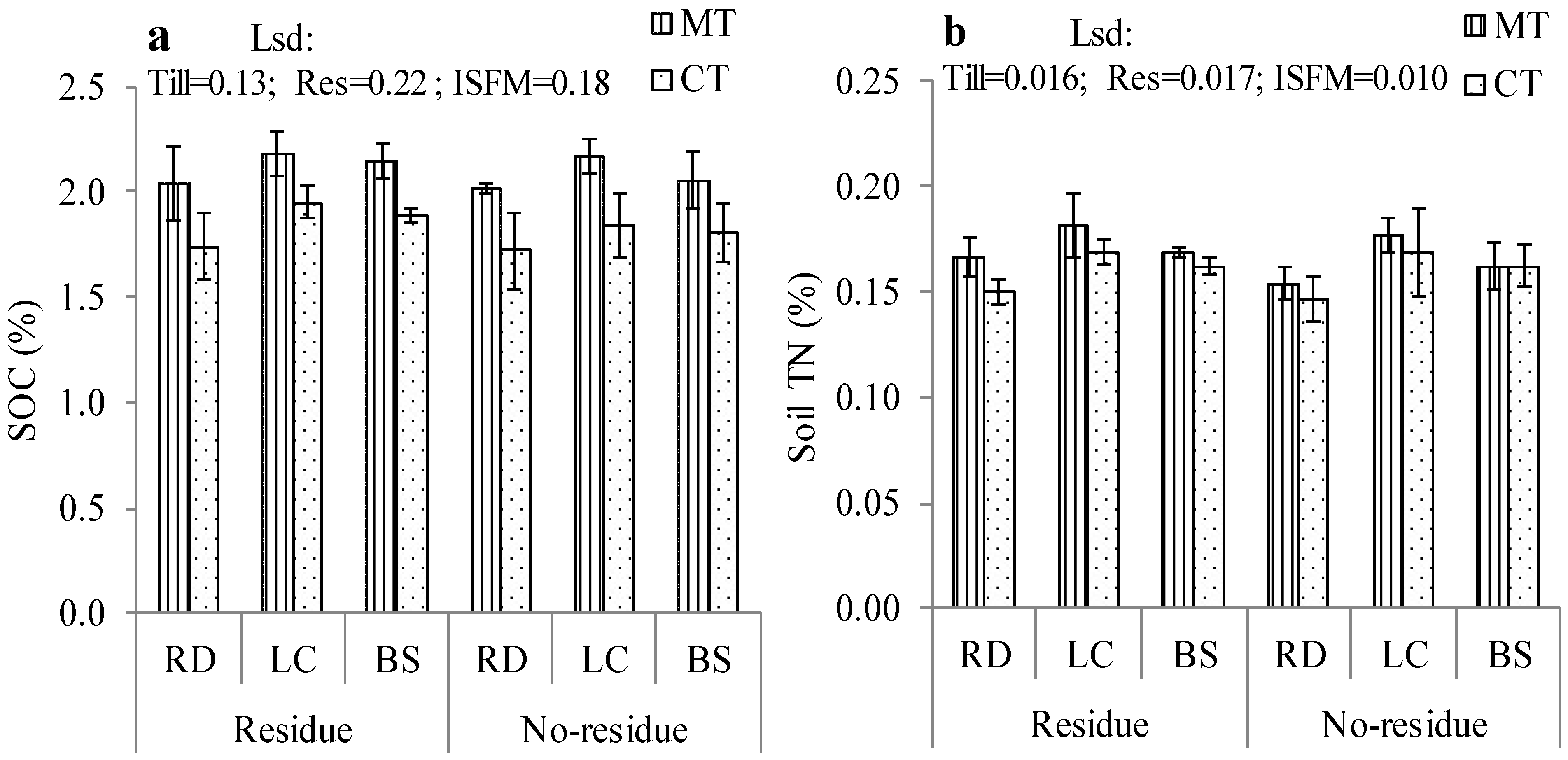Bio-Compost-Based Integrated Soil Fertility Management Improves Post-Harvest Soil Structural and Elemental Quality in a Two-Year Conservation Agriculture Practice
Abstract
:1. Introduction
2. Materials and Methods
2.1. Site Description
2.2. Preparation of Trichocompost
2.3. Experimental Design
2.4. Crop Management and Plant and Soil Sampling
2.5. Measurement of Soil Aggregate Properties
2.6. Analysis of Soil Chemical Properties
2.7. Calculation of Plant Nutrient Uptake and Use Efficiency
2.8. Statistical Analysis
3. Results
3.1. Quality of the Prepared Trichocompost
3.2. Management Impacts on System Productivity
3.3. Management Impacts on N Uptake and Use Efficiency in Transplanted Aman Rice (6th Crop)
3.4. Management Impacts on Soil Aggregate Mean Weight Diameter (MWD)
3.5. Management Impacts on Post-Harvest Soil Organic Carbon (SOC) and Total Nitrogen (TN) Contents
3.6. Management Impacts on Post-Harvest Soil-Available P and S
4. Discussion
4.1. Quality of Trichocompost
4.2. Effect of Management Practices on the System Productivity
4.3. Effect of Management Practices on N Uptake and Use Efficiency
4.4. Effect of Management Practices on Soil Aggregate MWD
4.5. Effect of Management Practices on Post-Harvest OC and TN Contents in Soils
4.6. Effect of Management Practices on Post-Harvest Soil-Available P and S Contents
5. Conclusions
Supplementary Materials
Author Contributions
Funding
Institutional Review Board Statement
Informed Consent Statement
Data Availability Statement
Acknowledgments
Conflicts of Interest
References
- Delgado, J.A.; Groffman, P.M.; Nearing, M.A.; Goddard, T.; Reicosky, D.; Lal, R.; Kitchen, N.R.; Rice, C.W.; Towery, D.; Salon, P. Conservation practices to mitigate and adapt to climate change. J. Soil Water Conserv. 2011, 66, 118–129. [Google Scholar] [CrossRef] [Green Version]
- Hasan, M.N.; Hossain, M.S.; Bari, M.A.; Islam, M.R. Agricultural Land Availability in Bangladesh; SRDI: Dhaka, Bangladesh, 2013; p. 42.
- Lal, R. Tillage effects on soil degradation, soil resilience, soil quality, and sustainability. Soil Till. Res. 1993, 27, 1–8. [Google Scholar] [CrossRef]
- Jahangir, M.M.R.; Jahiruddin, M.; Akter, H.; Pervin, R.; Islam, K.R. Cropping diversity with rice influences soil aggregate formation and nutrient storage under different tillage systems. J. Plant. Nutr. Soil Sci. 2021, 184, 150–161. [Google Scholar] [CrossRef]
- Chauhan, B.S.; Mahajan, G.; Sardana, V.; Timsina, J.; Jat, M.L. Productivity and sustainability of the rice–wheat cropping system in the Indo–Gangetic Plains of the Indian subcontinent: Problems, opportunities, and strategies. Advan. Agron. 2012, 117, 315–369. [Google Scholar]
- Lal, R. Sequestering carbon and increasing productivity by conservation agriculture. J. Soil Water Conserv. 2015, 70, 56–62. [Google Scholar] [CrossRef] [Green Version]
- Martínez, J.M.; Galantini, J.A.; Duval, M.E.; López, F.M. Soil quality assessment based on soil organic matter pools under long-term tillage systems and following tillage conversion in a semi humid region. Soil Use Manag. 2020, 36, 400–409. [Google Scholar] [CrossRef]
- Huang, M.; Zhuo, X.; Cao, F.; Xia, B.; Zou, Y. No-tillage effect on rice yield in China: A meta-analysis. Field Crops. Res. 2015, 183, 126–137. [Google Scholar] [CrossRef]
- Awale, R.; Emeson, M.A.; Machado, S. Soil organic carbon pools as early indicators for soil organic matter stock changes under different tillage practices in inland Pacific Northwest. Front. Ecol. Evol. 2017, 5, 96. [Google Scholar] [CrossRef] [Green Version]
- Liu, T.; Huang, J.; Chai, K.; Cao, C.; Li, C. Effects of N fertilizer sources and tillage practices on NH3 volatilization, grain yield, and N use efficiency of rice fields in central China. Front. Plant Sci. 2018, 9, 385. [Google Scholar] [CrossRef] [PubMed]
- IPCC. Climate Change: Synthesis Report; Intergovernmental Panel on Climate Change: Geneva, Switzerland, 2014. [Google Scholar]
- Dey, A.; Dwivedi, B.S.; Bhattacharyya, R.; Datta, S.P.; Meena, M.C.; Jat, R.K.; Gupta, R.K.; Jat, M.L.; Singh, V.K.; Das, D.; et al. Effect of conservation agriculture on soil organic and inorganic carbon sequestration, and their lability: A study from a rice–wheat cropping system on a calcareous soil of eastern Indo-Gangetic Plains. Soil Use Manag. 2018, 36, 429–438. [Google Scholar] [CrossRef]
- Young, M.D.; Ros, G.H.; de Vries, W. A decision support framework assessing management impacts on crop yield, soil carbon changes and nitrogen losses to the environment. Eur. J. Soil Sci. 2021, 72, 1590–1606. [Google Scholar] [CrossRef]
- Memon, M.S.; Guo, J.; Tagar, A.A.; Perveen, N.; Ji, C.; Memon, S.A.; Memon, N. The effects of tillage and straw incorporation on soil organic carbon status, rice crop productivity, and sustainability in the rice-wheat cropping system of Eastern China. Sustainability 2018, 10, 961. [Google Scholar] [CrossRef] [Green Version]
- Jat, H.S.; Datta, A.; Choudhary, M.; Yadav, A.K.; Choudhary, V.; Sharma, P.C.; Gathala, M.K.; Jat, M.L.; McDonald, A. Effects of tillage, crop establishment and diversification on soil organic carbon, aggregation, aggregate associated carbon and productivity in cereal systems of semi-arid Northwest India. Soil Till. Res. 2019, 190, 128–138. [Google Scholar] [CrossRef] [PubMed]
- Roobroeck, D.; Van Asten, P.J.A.; Jama, B.; Harawa, R.; Vanlauwe, B. Integrated Soil Fertility Management: Contributions of framework and practices to Climate-Smart Agriculture. In PRACTICE BRIEF Climate-Smart Agriculture; CGIAR Research Program on Climate Change, Agriculture and Food Security (CCAFS): Copenhagen, Denmark, 2015; Available online: https://hdl.handle.net/10568/69018 (accessed on 15 December 2020).
- Bilkis, S.; Islam, M.R.; Jahiruddin, M.; Rahman, M.M. Integrated use of manure and fertilizers increases rice yield, nutrient uptake and soil fertility in the Boro-fallow-T. Aman rice cropping pattern. SAARC J. Agric. 2017, 15, 147–161. [Google Scholar] [CrossRef] [Green Version]
- Matin, M.A.; Islam, M.N.; Muhammad, N.; Islam, M.R. Impact of Trichoderma enhanced composting technology on farmers’ livelihoods in Bangladesh. Int. J. Plant. Soil Sci. 2018, 25, 1–14. [Google Scholar] [CrossRef]
- Singh, D.P.; Prabha, R.; Renu, S.; Sahu, P.K.; Singh, V. Agrowaste bioconversion and microbial fortification have prospects for soil health, crop productivity, and eco-enterprising. Int. J. Recycl. Org. Waste Agric. 2019, 8, 457–472. [Google Scholar] [CrossRef] [Green Version]
- Fels, L.E.; Hayany, B.E.; Aguelmous, A.; Boutafda, A.; Zegzouti, Y.; Ghizlen, E.; Kouisni, L.; Hafidi, M. The Use of Microorganisms for the Biodegradation of Sewage Sludge and the Production of Bio-compost for Sustainable Agriculture. In Biofertilizers for Sustainable Agriculture and Environment; Giri, B., Prasad, R., Wu, Q.S., Varma, A., Eds.; Springer: Cham, Switzerland; New York, NY, USA, 2019; pp. 301–316. [Google Scholar]
- Islam, M.R.; Jahan, R.; Uddin, S.; Harine, I.J.; Hoque, M.A.; Hassan, S.; Hassan, M.M.; Hossain, M.A. Lime and Organic Manure Amendment Enhances Crop Productivity of Wheat-Mungbean-T. Aman Cropping Pattern in Acidic Piedmont Soils. Agriculture 2021, 11, 1595. [Google Scholar] [CrossRef]
- De Leenheer, L.; De Boodt, M. Determination of aggregate stability by change in mean weight diameter. Meded. Lundbouwhogeschool Gent 1967, 24, 290–300. [Google Scholar]
- Van Bavel, C.H.M. Mean Weight-Diameter of Soil Aggregates as a Statistical Index of Aggregation. Soil Sci. Soc. Am. J. 1950, 14, 20–23. [Google Scholar] [CrossRef] [Green Version]
- Zheng, H.; Liu, W.; Zheng, J.; Luo, Y.; Li, R.; Wang, H. Effect of long-term tillage on soil aggregates and aggregate-associated carbon in black soil of Northeast China. PLoS ONE 2018, 13, e0199523. [Google Scholar] [CrossRef]
- Walkley, A. A critical examination of a rapid method for determining organic carbon in soils-effect of variations in digestion conditions and of inorganic soil constituents. Soil Sci. 1947, 63, 251–264. [Google Scholar] [CrossRef]
- Fawcett, J.K. The semi-micro Kjeldahl method for the determination of nitrogen. J. Med. Lab. Technol. 1954, 12, 1–22. [Google Scholar]
- Olsen, S.R.; Cole, C.V.; Watanabe, F.S.; Dean, L.A. Estimation of Available Phosphorus in Soils by Extraction with Sodium Bicarbonate; United States Department of Agriculture, Circular 939; United States Government Printing Office: Washington, DC, USA, 1954.
- Williams, C.H.; Steinbergs, A. Soil sulfur fractions as chemical indices of available sulfur in some Australian soils. Aus. J. Agric. Res. 1959, 10, 340–352. [Google Scholar] [CrossRef]
- Weih, M.; Hamnér, K.; Pourazari, P. Analyzing plant nutrient uptake and utilization efficiencies: Comparison between crops and approaches. Plant. Soil 2018, 430, 7–21. [Google Scholar] [CrossRef] [Green Version]
- EUNEP. Nitrogen Use Efficiency (NUE)—An Indicator for the Utilization of Nitrogen in Agriculture and Food Systems; Wageningen University: Wageningen, The Netherlands, 2015. [Google Scholar]
- Masunga, R.H.; Uzokwe, V.N.; Mlay, P.D.; Odeh, I.; Singh, A.; Buchan, D.; de Neve, S. Nitrogen mineralization dynamics of different valuable organic amendments commonly used in agriculture. Appl. Soil Ecol. 2016, 101, 185–193. [Google Scholar] [CrossRef]
- Zeb, H.; Hussain, A.; Naveed, M.; Ditta, A.; Ahmad, S.; Jamshaid, M.U.; Ahmad, H.T.; Hussain, M.B.; Aziz, R.; Haider, M.S. Compost enriched with ZnO and Zn-solubilizing bacteria improves yield and Zn-fortification in flooded rice. Ital. J. Agron. 2018, 13, 310–316. [Google Scholar] [CrossRef]
- Rahman, M.S.; Haque, M.A.; Salam, M.A. Effect of different tillage practices on growth, yield and yield contributing characters of transplanted Aman rice (BRRI Dhan-33). Agron. J. 2004, 3, 103–110. [Google Scholar]
- Alam, M.K.; Islam, M.M.; Salahin, N.; Hasanuzzaman, M. Effect of tillage practices on soil properties and crop productivity in wheat-mungbean-rice cropping system under subtropical climatic conditions. Sci. World J. 2014, 437283. [Google Scholar] [CrossRef] [Green Version]
- Arvidsson, J.; Håkansson, I. Does soil compaction persist after ploughing—Results from 21 long-term field experiments? Soil Till. Res. 1996, 39, 175–198. [Google Scholar] [CrossRef]
- De Cárcer, P.S.; Sinaj, S.; Santonja, M.; Fossati, D.; Jeangros, B. Long-term effects of crop succession, soil tillage and climate on wheat yield and soil properties. Soil Till. Res. 2019, 190, 209–2019. [Google Scholar] [CrossRef]
- Nandan, R.; Singh, V.; Singh, S.S.; Kumar, V.; Hazra, K.K.; Nath, C.P.; Pooni, S.; Malik, R.K.; Bhattacharyya, R.; McDonald, A. Impact of conservation tillage in rice–based cropping systems on soil aggregation, carbon pools and nutrients. Geoderma 2019, 340, 104–114. [Google Scholar] [CrossRef]
- Yadav, G.S.; Datta, R.; Pathan, S.I.; Lal, R.; Meena, R.S.; Babu, S.; Das, A.; Bhowmik, S.N.; Datta, M.; Saha, P.; et al. Effects of conservation tillage and nutrient management practices on soil fertility and productivity of rice in North Eastern Region of India. Sustainability 2017, 9, 1816. [Google Scholar] [CrossRef] [Green Version]
- Jahangir, M.M.R.; Jahan, I.; Mumu, N.J. Management of soil resources for sustainable development under a changing climate. J. Environ. Sci Nat. Resour 2018, 11, 159–170. [Google Scholar] [CrossRef]
- Hossain, I.; Sarker, M.J.U.; Hoque, M.A. Status of conservation agriculture-based tillage technology for crop production in Bangladesh. Bangladesh. J. Agric Res. 2015, 40, 235–248. [Google Scholar] [CrossRef]
- Lu, X. A meta-analysis of the effects of crop residue returns on crop yields and water use efficiency. PLoS ONE 2020, 15, e0231740. [Google Scholar] [CrossRef] [PubMed]
- Srivastava, P.K.; Gupta, M.; Upadhyay, R.K.; Sharma, S.; Singh, N.; Tewari, S.K.; Singh, B. Effects of combined application of vermin-compost and mineral fertilizer on the growth of Allium cepa and soil fertility. J. Soil Sci. Plant. Nutr. 2012, 175, 101–107. [Google Scholar] [CrossRef]
- Uddin, U.; Nitu, T.T.; Milu, U.M.; Nasreen, S.S.; Hosenuzzaman, M.; Haque, M.E.; Hossain, B.; Jahiruddin, M.; Bell, R.W.; Müller, C.; et al. Ammonia fluxes and emission factors under an intensively managed wetland rice ecosystem. Environ. Sci. Process. Impacts 2021, 23, 132–143. [Google Scholar] [CrossRef] [PubMed]
- Haque, M.A.; Jahiruddin, M.; Islam, M.S.; Rahman, M.M.; Saleque, M.A. Effect of bioslurry on the yield of wheat and rice in the wheat–rice cropping system. Agric. Res. 2018, 7, 432–442. [Google Scholar] [CrossRef]
- Hu, C.; Xia, X.G.; Chen, Y.F.; Qiao, Y.; Liu, D.H.; Fan, J.; Li, S.L. Yield, nitrogen use efficiency and balance response to thirty-five years of fertilization in paddy rice-upland wheat cropping system. Plant. Soil Environ. 2019, 65, 55–62. [Google Scholar]
- Abbasi, M.K.; Hina, M.; Khalique, A.; Khan, S.R. Mineralization of Three Organic Manures Used as Nitrogen Source in a Soil Incubated under Laboratory Conditions. Commun. Soil Sci. Plant. Anal. 2007, 38, 1691–1711. [Google Scholar] [CrossRef]
- Celar, F.; Valic, N. Effects of Trichoderma spp. and Glicladium roseum culture filtrates on seed germination of vegetables and maize. J. Plant. Dis. Protect. 2005, 112, 343–350. [Google Scholar]
- Asghari, H.R.; Cavagnaro, T.R. Arbuscular mycorrhizae as enhance plant interception of leached nutrients. Funct. Plant. Biol. 2011, 38, 219–226. [Google Scholar] [CrossRef] [PubMed]
- San Francisco, S.; Urrutia, O.; Martin, V.; Peristeropoulos, A.; Garcia-Mina, J.M. Efficiency of urease and nitrification inhibitors in reducing ammonia volatilization from diverse nitrogen fertilizers applied to different soil types and wheat straw mulching. J. Soc. Food Agric. 2011, 91, 1569–1575. [Google Scholar] [CrossRef]
- Yang, C.; Xu, S.; Liu, L.; Huang, M.; Zheng, T.; Wei, S.; Zhang, Y.; Deng, G.; Jiang, L. Nitrogen uptake and utilization by no-tillage rice under different soil moisture conditions—A model study under simulated soil conditions. Plant. Product Sci. 2015, 18, 118–127. [Google Scholar] [CrossRef] [Green Version]
- Agegnehu, G.; Nelson, P.N.; Bird, M.I. Crop yield, plant nutrient uptake and soil physicochemical properties under organic soil amendments and nitrogen fertilization on nitisols. Soil Till. Res. 2016, 160, 1–13. [Google Scholar] [CrossRef]
- Takahashi, S.; Uenosono, S.; Ono, S. Short and long-term effects of rice straw application on nitrogen uptake by crops and nitrogen mineralization under flooded and upland conditions. Plant. Soil 2003, 251, 291–301. [Google Scholar] [CrossRef]
- Phongpan, S.; Mosier, A. Impact of organic residue management on nitrogen use efficiency in an annual rice cropping sequence of lowland Central Thailand. Nutr. Cycl. Agroecosyst. 2003, 66, 233–240. [Google Scholar] [CrossRef]
- Li, L.Q.; Zhang, X.H.; Zhang, P.J.; Zheng, J.F.; Pan, G.X. Variation of organic carbon and nitrogen in aggregate size fractions of a paddy soil under fertilization practices from Tai Lake Region, China. J. Sci. Food Agric. 2007, 87, 1052–1058. [Google Scholar] [CrossRef]
- Kihara, J.A.; Bationo, D.N.; Mugendi, C.; Martius, C.; Vlek, P.L.G. Conservation tillage, local organic resources and nitrogen fertilizer combinations affect maize productivity, soil structure and nutrient balances in semi-arid Kenya. Nutr. Cycl. Agroecosyst. 2011, 90, 213–225. [Google Scholar] [CrossRef]
- Amézketa, E.; Aragüés, R.; Carranza, R.; Urgel, B. Macro-and micro-aggregate stability of soils determined by a combination of wet-sieving and laser-ray diffraction. Span. J. Agric. Res. 2003, 1, 83–94. [Google Scholar] [CrossRef] [Green Version]
- Nyamadzawo, G.; Nyamangara, J.; Nyamugafata, P.; Muzulu, A. Soil microbial biomass and mineralization of aggregate protected carbon in fallow-maize systems under conventional and no-tillage in Central Zimbabwe. Soil Till. Res. 2009, 102, 151–157. [Google Scholar] [CrossRef]
- Fuentes, M.; Hidalgo, C.; Etchevers, J.; De León, F.; Guerrero, A.; Dendooven, L.; Verhulst, N.; Govaerts, B. Conservation agriculture increased organic carbon in the topsoil macro-aggregates and reduced soil CO2 emissions. Plant. Soil 2012, 355, 183–197. [Google Scholar] [CrossRef]
- Six, J.; Elliott, E.T.; Paustian, K. Soil macroaggregate turnover and microaggregate formation: A mechanism for C sequestration under no-tillage agriculture. Soil Biol. Biochem. 2000, 2, 2099–2103. [Google Scholar] [CrossRef]
- Bronick, C.J.; Lal, L. Soil structure and management: A review. Geoderma 2005, 124, 3–22. [Google Scholar] [CrossRef]
- Blanco-Moure, N.; Moret-Fernández, D.; López, M.V. Dynamics of aggregate destabilization by water in soils under long-term conservation tillage in semiarid Spain. Catena 2012, 99, 34–41. [Google Scholar] [CrossRef] [Green Version]
- Chu, J.; Zhang, T.; Chang, W.; Zhang, D.; Zulfiqar, S.; Fu, A. Impacts of cropping systems on aggregates associated organic carbon and nitrogen in a semiarid highland agroecosystem. PLoS ONE 2016, 11, e0165018. [Google Scholar] [CrossRef] [Green Version]
- Tivet, F.; de Moraes Sá, J.C.; Lal, R.; Briedis, C.; Borszowskei, P.R.; dos Santos, J.B.; Farias, A.; Eurich, G.; Hartman, D.D.C.; Nadolny, J.M.; et al. Aggregate C depletion by plowing and its restoration by diverse biomass-C inputs under no-till in sub-tropical and tropical regions of Brazil. Soil Till. Res. 2013, 126, 203–218. [Google Scholar] [CrossRef]
- Zhou, M.; Liu, C.; Wang, J.; Meng, Q.; Yuan, Y.; Ma, X.; Liu, X.; Zhu, Y.; Ding, G.; Zhang, J.; et al. Soil aggregate stability and storage of soil organic carbon respond to cropping systems on Black Soils of Northeast China. Sci. Rep. 2020, 10, 265. [Google Scholar] [CrossRef] [PubMed]
- Sainju, U.M.; Whitehead, W.F.; Singh, B.P. Cover crops and nitrogen fertilization effects on soil aggregation and carbon and nitrogen pools. Can. J. Soil Sci. 2003, 83, 155–165. [Google Scholar] [CrossRef]
- Caravaca, F.; Lax, A.; Albaladejo, J. Soil aggregate stability and organic matter in clay and fine silt fractions in urban refuse-amended semiarid soils. Soil Sci. Soc. Am. J. 2001, 65, 1235–1238. [Google Scholar] [CrossRef]
- Yu, H.Y.; Ding, W.X.; Luo, J.F.; Geng, R.L.; Cai, Z.C. Long-term application of organic manure and mineral fertilizers on aggregation and aggregate-associated carbon in a sandy loam soil. Soil Till. Res. 2012, 124, 170–177. [Google Scholar] [CrossRef]
- Huang, S.; Peng, X.X.; Huang, Q.R.; Zhang, W.J. Soil aggregation and organic carbon fractions affected by long-term fertilization in a red soil of subtropical China. Geoderma 2010, 154, 364–369. [Google Scholar] [CrossRef]
- Guo, Z.; Zhang, L.; Yang, W.; Hua, L.; Cai, C. Aggregate stability under long-term fertilization practices: The case of eroded Ultisols of South-Central China. Sustainability 2019, 11, 1169. [Google Scholar] [CrossRef] [Green Version]
- Mikha, M.M.; Hergert, G.W.; Benjamin, J.G.; Jabro, J.D.; Nielsen, R.A. Long-term manure impacts on soil aggregates and aggregate-associated carbon and nitrogen. Soil Sci. Soc. Am. J. 2015, 79, 626–636. [Google Scholar] [CrossRef]
- Khorami, S.S.; Kazemeini, S.A.; Afzalinia, A.; Gathala, M.K. Changes in soil properties and productivity under different tillage practices and wheat genotypes: A Short-term study in Iran. Sustainability 2018, 10, 3273. [Google Scholar] [CrossRef] [Green Version]
- Mazzoncini, M.; Sapkota, T.B.; Bàrberi, P.; Antichi, D.; Risalati, R. Long-term effect of tillage, nitrogen fertilization and cover crops on soil organic carbon and total nitrogen content. Soil Till. Res. 2011, 114, 165–174. [Google Scholar] [CrossRef]
- Tian, Q.; He, H.; Cheng, W.; Bai, Z.; Wang, Y.; Zhang, X. Factors controlling soil organic carbon stability along a temperate forest altitudinal gradient. Sci. Rep. 2016, 6, 18783. [Google Scholar] [CrossRef] [Green Version]
- Diekow, J.; Mielniczuk, J.; Knicker, H.; Bayer, C.; Dick, D.P.; Kögel-Knabner, I. Soil C and N stocks as affected by cropping systems and N fertilization in the southern Brazil Acrisol managed under no-tillage for 17 years. Soil Till. Res. 2005, 81, 87–95. [Google Scholar] [CrossRef]
- Kheyrodin, H.; Ghazvininan, K.; Taherian, M. Tillage and manure effect on soil microbial biomass and respiration, and on enzyme activities. Afr. J. Biotechnol. 2012, 11, 14652–14659. [Google Scholar]
- Datta, A.; Jat, H.S.; Yadav, A.K.; Choudhary, M.; Sharma, P.C.; Rai, M.; Kumar, L.; Majumder, S.P.; Choudhary, V.; Jat, M.L. Carbon mineralization in soil as influenced by crop residue type and placement in an Alfisols of Northwest India. Carbon Manag. 2019, 10, 37–50. [Google Scholar] [CrossRef]
- Ren, T.; Wang, J.; Chen, Q.; Zhang, F.; Lu, S. The effects of manure and nitrogen fertilizer applications on soil organic carbon and nitrogen in a high-input cropping system. PLoS ONE 2014, 9, e97732. [Google Scholar] [CrossRef]
- Zhao, Z.; Zhang, C.; Li, F.; Gao, S.; Zhang, J. Effect of compost and inorganic fertilizer on organic carbon and activities of carbon cycle enzymes in aggregates of an intensively cultivated Vertisol. PLoS ONE 2020, 15, e0229644. [Google Scholar] [CrossRef] [PubMed]
- Soane, B.; Bruce, C.; Ball, B.C.; Arvidsson, J.; Basch, G.; Moreno, F.; Roger-Estade, J. No-till in northern, western and south western Europe: A review of problems and opportunities for crop production and the environment. Soil Till. Res. 2012, 118, 66–87. [Google Scholar] [CrossRef] [Green Version]
- Asenso, E.; Li, J.; Hu, L.; Issaka, F.; Tian, K.; Zhang, L.; Chen, H. Tillage effects on soil biochemical properties and maize grown in latosolic red soil of southern China. Appl. Environ. Soil Sci. 2018, 2018, 8426736. [Google Scholar]
- Zhou, W.; Li, S.T.; Wang, H.; He, P.; Lin, B. Mineralization of organic sulfur and its importance as a reservoir of plant-available sulfur in upland soils of north China. Biol. Fert. Soils 1999, 30, 245–250. [Google Scholar] [CrossRef]
- Samuel, A.L.; Ebenezer, A.O. Mineralization rates of soil forms of nitrogen, phosphorus, and potassium as affected by organo-mineral fertilizer in sandy loam. Adv. Agric. 2014, 2014, 1–5. [Google Scholar] [CrossRef] [Green Version]
- Durrer, A.; Gumiere, T.; Rumenos Guidetti Zagatto, M.; Petry Feiler, H.; Miranda Silva, A.M.; Henriques Longaresi, R.; Homma, S.K.; Cardoso, E.J.B.N. Organic farming practices change the soil bacteria community, improving soil quality and maize crop yields. PeerJ 2021, 9, e11985. [Google Scholar] [CrossRef] [PubMed]







| pH | Soil Organic Carbon (SOC) | Total Nitrogen (TN) | Available Phosphorus (P) | Exchangeable Potassium (K) | Available Sulphur (S) | Available Zinc (Zn) | Cadmium (Cd) | Nickel (Ni) | Lead (Pb) | Copper (Cu) |
|---|---|---|---|---|---|---|---|---|---|---|
| (%) | (ppm) | |||||||||
| 6.45 | 1.62 | 0.11 | 10.44 | 31.2 | 2.56 | 1.10 | 0.01 | 0.05 | 0.50 | 4.2 |
| Organics | pH | Moisture (%) | Avail. P (ppm) | Avail. S (ppm) | Exch. K (meq./100 g) | Organic Matter (%) | Total N (%) | C/N Ratio |
|---|---|---|---|---|---|---|---|---|
| LC | 7.7 ± 0.02 | 14.2 ± 1.04 | 158.4 ± 13.0 | 80.2 ± 6.1 | 45 ± 8.4 | 48.9 ± 0.2 | 1.5 ± 0.1 | 18.8 ± 2.0 |
| BS | 6.8 ± 0.02 | 30.0 ± 3.0 | 60.6 ± 12.0 | 28.0 ± 4.2 | 30.4 ± 5.3 | 18.3 ± 3.2 | 1.0 ± 0.0 | 11.0 ± 2.3 |
| Cr | Cd | Pb | Ni | Zn | Cu |
|---|---|---|---|---|---|
| (ppm) | |||||
| <MDL (18.28) | 0.01 (0.18) | 0.50 (22.50) | 0.05 (24.44) | 1.51 (400) | 3.91 (160) |
Publisher’s Note: MDPI stays neutral with regard to jurisdictional claims in published maps and institutional affiliations. |
© 2021 by the authors. Licensee MDPI, Basel, Switzerland. This article is an open access article distributed under the terms and conditions of the Creative Commons Attribution (CC BY) license (https://creativecommons.org/licenses/by/4.0/).
Share and Cite
Jahangir, M.M.R.; Islam, S.; Nitu, T.T.; Uddin, S.; Kabir, A.K.M.A.; Meah, M.B.; Islam, R. Bio-Compost-Based Integrated Soil Fertility Management Improves Post-Harvest Soil Structural and Elemental Quality in a Two-Year Conservation Agriculture Practice. Agronomy 2021, 11, 2101. https://doi.org/10.3390/agronomy11112101
Jahangir MMR, Islam S, Nitu TT, Uddin S, Kabir AKMA, Meah MB, Islam R. Bio-Compost-Based Integrated Soil Fertility Management Improves Post-Harvest Soil Structural and Elemental Quality in a Two-Year Conservation Agriculture Practice. Agronomy. 2021; 11(11):2101. https://doi.org/10.3390/agronomy11112101
Chicago/Turabian StyleJahangir, Mohammad Mofizur Rahman, Shanta Islam, Tazbeen Tabara Nitu, Shihab Uddin, Abul Kalam Mohammad Ahsan Kabir, Mohammad Bahadur Meah, and Rafiq Islam. 2021. "Bio-Compost-Based Integrated Soil Fertility Management Improves Post-Harvest Soil Structural and Elemental Quality in a Two-Year Conservation Agriculture Practice" Agronomy 11, no. 11: 2101. https://doi.org/10.3390/agronomy11112101
APA StyleJahangir, M. M. R., Islam, S., Nitu, T. T., Uddin, S., Kabir, A. K. M. A., Meah, M. B., & Islam, R. (2021). Bio-Compost-Based Integrated Soil Fertility Management Improves Post-Harvest Soil Structural and Elemental Quality in a Two-Year Conservation Agriculture Practice. Agronomy, 11(11), 2101. https://doi.org/10.3390/agronomy11112101







